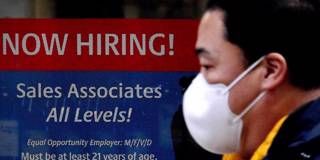Given the unprecedented nature of the COVID-19 pandemic and its effects on labor markets, there is a spirited debate over whether the US economy is close to returning to its full potential. If it is, the US Federal Reserve is at risk of falling behind the curve.
NEW YORK – How much slack is there in the US economy? In economics, the “gap version” of Okun’s law holds that a one-percentage-point increase in the unemployment rate is associated with a two-point decline in the real (inflation-adjusted) GDP growth rate below its potential. The gap matters, because the closer the economy is to its potential, the more we should worry about inflation.
According to the Bureau of Labor Statistics (BLS), the US unemployment rate was 5.9% in June, compared to the pre-pandemic (February 2020) rate of 3.5%. If we take the latter figure as an estimate of the natural unemployment rate, we get an output gap of 4.8%. Assuming potential output grows at an annual rate of 2%, non-inflationary real GDP growth for the coming year would hit 6.8%. Since the US Federal Reserve expects 7% growth this year and 3.3% growth in 2022, that would suggest the US is still at least a couple of years away from the inflation threshold.
This guesstimate of the output gap can be criticized as either too low or too high. The too-low camp argues that the official unemployment numbers – 9.5 million in June 2021, as against 5.7 million in February 2020 – underestimate the amount of slack in the labor market. The BLS reports that in June, “the number of persons not in the labor force who currently want a job was 6.4 million,” an increase of “1.4 million since February 2020.” After accounting for those additional 1.4 million, the unemployment rate rises to 6.8%, yielding an output gap of 6.6%.

NEW YORK – How much slack is there in the US economy? In economics, the “gap version” of Okun’s law holds that a one-percentage-point increase in the unemployment rate is associated with a two-point decline in the real (inflation-adjusted) GDP growth rate below its potential. The gap matters, because the closer the economy is to its potential, the more we should worry about inflation.
According to the Bureau of Labor Statistics (BLS), the US unemployment rate was 5.9% in June, compared to the pre-pandemic (February 2020) rate of 3.5%. If we take the latter figure as an estimate of the natural unemployment rate, we get an output gap of 4.8%. Assuming potential output grows at an annual rate of 2%, non-inflationary real GDP growth for the coming year would hit 6.8%. Since the US Federal Reserve expects 7% growth this year and 3.3% growth in 2022, that would suggest the US is still at least a couple of years away from the inflation threshold.
This guesstimate of the output gap can be criticized as either too low or too high. The too-low camp argues that the official unemployment numbers – 9.5 million in June 2021, as against 5.7 million in February 2020 – underestimate the amount of slack in the labor market. The BLS reports that in June, “the number of persons not in the labor force who currently want a job was 6.4 million,” an increase of “1.4 million since February 2020.” After accounting for those additional 1.4 million, the unemployment rate rises to 6.8%, yielding an output gap of 6.6%.